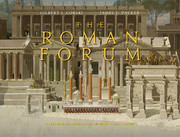Book contents
- Frontmatter
- Map
- Contents
- Preface
- Acknowledgments
- Part I. Architecture in the Roman Forum during the Empire: A Brief History
- Part II. The Monuments
- 3 The Temple of Antoninus and Faustina
- 4 The Temple of Caesar (Aedes divi Iuli)
- 5 The Basilica Æmilia
- 6 The Curia
- 7 The Arch of Septimius Severus
- 8 Minor Monuments
- 9 The Temple of Concord
- 10 The Temple of Vespasian
- 11 The Tabularium
- 12 The Portico of the Dei Consentes
- 13 The Temple of Saturn
- 14 The Basilica Julia
- 15 The Arch of Tiberius
- 16 The Schola Xanthi
- 17 The Diocletianic Honorary Columns
- 18 The Temple of Castor and Pollux
- 19 The Parthian Arch of Augustus (19 BCE)
- 20 The Temple of Vesta
- Part III. Conclusions
- Glossary
- Notes
- Bibliography
- Sources for Coin Images from the Internet and for Other Images
- Index
20 - The Temple of Vesta
from Part II. - The Monuments
Published online by Cambridge University Press: 05 March 2015
- Frontmatter
- Map
- Contents
- Preface
- Acknowledgments
- Part I. Architecture in the Roman Forum during the Empire: A Brief History
- Part II. The Monuments
- 3 The Temple of Antoninus and Faustina
- 4 The Temple of Caesar (Aedes divi Iuli)
- 5 The Basilica Æmilia
- 6 The Curia
- 7 The Arch of Septimius Severus
- 8 Minor Monuments
- 9 The Temple of Concord
- 10 The Temple of Vespasian
- 11 The Tabularium
- 12 The Portico of the Dei Consentes
- 13 The Temple of Saturn
- 14 The Basilica Julia
- 15 The Arch of Tiberius
- 16 The Schola Xanthi
- 17 The Diocletianic Honorary Columns
- 18 The Temple of Castor and Pollux
- 19 The Parthian Arch of Augustus (19 BCE)
- 20 The Temple of Vesta
- Part III. Conclusions
- Glossary
- Notes
- Bibliography
- Sources for Coin Images from the Internet and for Other Images
- Index
Summary
Foundation
The Temple of Vesta (Figs. 0.1, 3, 20.1–19), one of the oldest sacred buildings in the Roman Forum, was first built by Numa Pompilius, Rome’s second king (715–673 BCE) and founder of the order of Vestals. As Romulus had shaped the military and political character of the early Roman state, so, says Plutarch, Numa, an austere religious man, gave Roman religion its earliest form. He established state priests (the pontifices or those who build bridges between the human and divine) and became their chief, the Pontifex Maximus. As a pious ruler concerned about the relations between his subjects and their gods, Numa was particularly interested in the cult of Vesta, believed to be a sister of Jupiter and patron of the domestic hearth. As a symbol of the goddess’ close association with the state, her temple was set up at the southeast side of the Forum, near the Fountain of Juturna and the Temple of Castor and Pollux, just across from the Regia, traditionally supposed to be the palace of the kings and, after the establishment of the Roman Republic in 509 BCE, the ceremonial “office” for the Pontifex Maximus (Figs. 0.1, 1.5, 13–14). Never formally considered a temple, Vesta’s shrine was unconsecrated. Indeed, it lacked a cult statue, and the representation of the goddess stood nearby in the Aedicula Vestae, a small tabernacle next to the entrance to the house of the Vestal Virgins
- Type
- Chapter
- Information
- The Roman ForumA Reconstruction and Architectural Guide, pp. 313 - 332Publisher: Cambridge University PressPrint publication year: 2015



